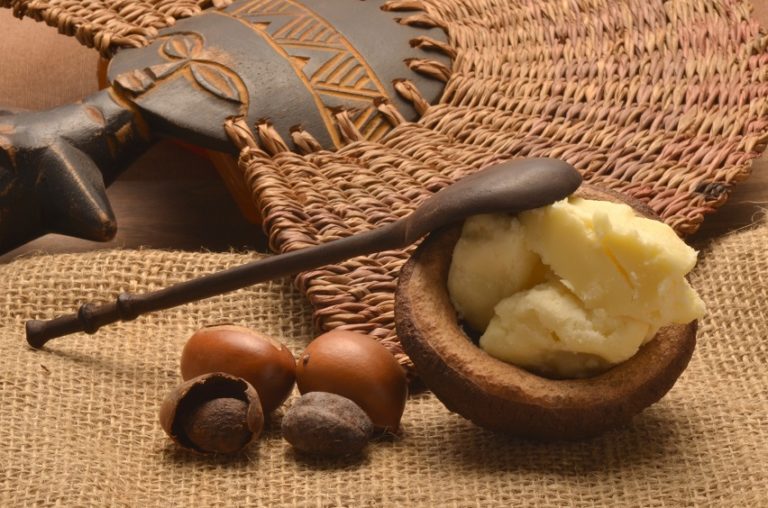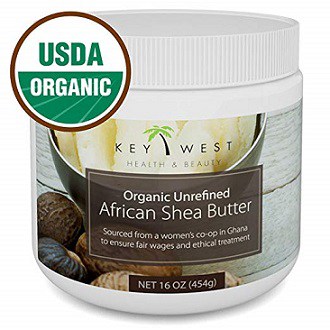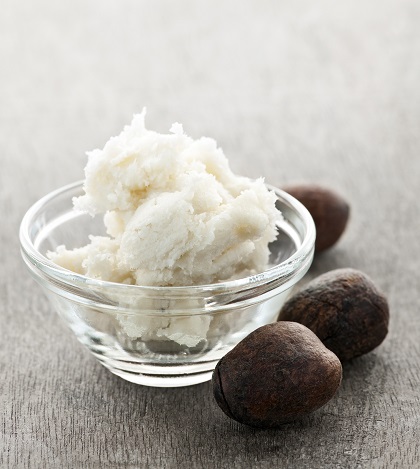Shea butter, sourced from the vast continent of Africa, is one of the most beloved natural moisturisers for keeping the skin soft and supple.
If you’re somebody who shuns commercial moisturisers due to the red and blotchy acne they trigger, then you’ve almost certainly heard of shea butter already. Firstly, this traditional fat has one immediate advantage: a comedogenic rating of 0 out of 5. There’s almost no chance of shea butter clogging your skin pores, barely any chance that you’ll unwittingly give p.acnes bacteria a whole new estate of homes free from charge.
Cocoa butter and coconut oil both score 4 out of 5, and that’s why despite their lauric acid and vitamin E, I strongly recommend against them. Shea butter even defeats jojoba oil and grapeseed oil, which are perfectly safe for acne, but both score 2 out of 5.
Shea butter has one nice trick up its sleeve already, but that doesn’t gain it an automatic recommendation for acne. If its moisturising powers don’t work, then never clogging your pores is irrelevant.
Therefore, our questions for today are 1) whether shea butter actually moisturises human skin, and 2) whether it’s hiding any less obvious acne side effects. Let’s go:
Africa’s favourite moisturiser
Shea butter, in short, is the fat extracted from the nut of the African shea tree. It has an ivory colour, a unique nutty aroma, and is solid at room temperature (21C).
In western countries, this fat is used as a cosmetics ingredient, particularly in high end moisturisers and soaps, and as a substitute for cocoa butter in chocolate whenever the price is on one of its cyclical surges, providing a similar yet subtly different taste.
That said, shea butter originated from Africa, and Africa has always been the heartland of its popularity. Almost all African historical records mention shea butter in some form. One ancient Egyptian text, for example, discusses caravans bearing clay jars of shea butter arriving for cosmetic usage, while another mentions Cleopatra using it.
Ancient African kings were buried in coffins made from the shea tree’s wood, and today, shea butter remains rampantly popular in local villages as a moisturiser and homemade soap ingredient. In northeast Ghana, pregnant women traditionally apply shea butter to their bellies to prevent stretch marks. Shea butter is also used to moisturise newborn babies and rubbed into the umbilical stump to minimise bacterial infections and prevent infant mortality.
Read Annihilate Your Acne – learn to prevent acne and stop just treating it!
Over in Togo, shea butter is a staple in every aspect of life. In the Fulani tribe, every bride is ordered to apply shea butter to her face and arms for at least three months before her wedding day, to enrich her skin tone. The groom also gets to enjoy shea butter, but in a slightly less pleasant way. For 3 months before wedding day, the bride’s parents whip his chest 30 times a day, to establish precisely how much he loves their daughter. Luckily, a mixture of soothing shea butter and wild honey is on hand to heal the pain.
The entire shea tree is utilised. The red liquid remaining after butter extraction is used as bricks to build houses, supposedly to ward off termites, with artists also grabbing a handful for their red colours. Even the most deprived Togan will have shea butter applied to his or her body almost every day of life, from newborn baby to wise old village elder 70 years later.
All in all, shea butter might be the most popular moisturiser in sub-Saharan Africa.
In the West, everybody is obsessed with Ayurvedic medicine and traditional Chinese remedies. Nobody cares about the likes of crocodile oil (maybe they’re scared of a real crocodile bursting out of the bottle).
Shea butter, however, is one skincare remedy which has finally departed the shores of Africa. It’s so effective that it cannot be ignored.
Confirmed – the moisturising powers of shea butter
 Back in the 1940s, some scientists visiting Africa confirmed that skin conditions were particularly rare in populations using shea butter. These were casual observations, so it’s perfectly possible that other factors were at play. Black skin is very different to white skin as well, so it’s even possible that the Western scientists were unaccustomed to analysing black skin and reached and failed to reach a judgement properly.
Back in the 1940s, some scientists visiting Africa confirmed that skin conditions were particularly rare in populations using shea butter. These were casual observations, so it’s perfectly possible that other factors were at play. Black skin is very different to white skin as well, so it’s even possible that the Western scientists were unaccustomed to analysing black skin and reached and failed to reach a judgement properly.
Even without accurate data though, I’d deem shea butter to be extremely promising based solely on its thousand year track record of usage.
One study was conducted on 10 humans, with a cream consisting of 5% shea butter rubbed into their forearms. Compared to a placebo cream, the shea butter worked excellently as a short term moisturiser. The improvements peaked after 1 hour and persisted for up to 8 hours. With daily application, the shea butter effectively hydrated the outermost layers of the skin in all participants.
A separate study tested trans-epidermal water loss (TEWL), the quantity of water vapour lost through the outermost layers of skin. After the scientists deliberately increased the TEWL of participants by washing their skin in ethanol, shea butter reversed every last piece of damage within just 2 hours, beating a mineral oil resoundingly.
The top 6 vitamins and minerals for clearing acne forever
Shea butter also decreased skin dryness in patients with both eczema and dermatitis. A scale was devised where 5 indicated severe eczema and 0 indicated clear skin, and shea butter slashed the eczema score from 3 to 1. Vaseline, meanwhile, the petroleum jelly found in commercial moisturisers everywhere, only managed 3 to 2.
Like any great moisturiser, shea butter dabbles in the photoprotection arena as well, increasing the resistance of human skin to UV radiation.
Depending on who you ask, shea butter has a sun protection factor (SPF) of between 3 and 4 or between 3 and 6. We can safely say that it’s at least 3, and a topical remedy’s SPF determines how many extra minutes you can spend in sunlight without inflaming your skin (and acne). Scoring 3 indicates an extra 30 minutes for every ten minutes.
Some of the main bioactive compounds in shea butter are cinnamic acid esters, which strongly absorb UV radiation in the wavelengths of 250-300nm. Consider that the range in sunlight which creates free radicals is 290-320nm.
In fact, protection against the harsh wind and sunlight is theorised to be why shea butter was imported into the Ancient Egyptian deserts all those millennia ago. Soldiers roaming the desert were in serious need of a natural sunscreen before the word pharmacist was ever invented; the same goes for conquering Roman soldiers centuries later, whose paler skin was even less adapted.
The other acne powers reviewed
For acne itself, shea butter has several promising plant compounds, not least the triterpenes a-amyrin and beta-amyrin. Both were shown to calm inflammatory swelling in mice, reducing acne-causing chemicals such as COX-2 and neutrophils. Shea butter itself is able to calm the inflammation of common chemical skin irritants.
However, the most promising acne power which is completely proven is accelerating collagen production, the main anti-aging protein in humans, your buffer against thinner skin and wrinkles.
It all started with a couple of studies by Dr Renard starting in 1990. One featured 49 humans applying shea butter twice daily, who enjoyed significant reductions in dry, delicate ageing skin. The second study had 30 volunteers, with numerous signs of ageing improving.
Collagen formation increased in both studies, and the most interesting aspect of shea butter is its mechanism: inhibiting collagenase on the skin’s surface.
Down in the gut, you have numerous digestive enzymes: lipase for digesting fats, amylase for digesting carbohydrates, and phytase for breaking down phytic acid. Humans also produce protease, which breaks down proteins.
Recommended – the 7 greatest natural topical treatments for acne
Perhaps you can work out where this is heading. Collagenase is an enzyme that breaks down collagen supplies, to prevent an overgrowth or to recycle older, weaker tissue. In shea butter, there are two compounds called a-amyrin and lupeol which deactivate that collagenase, leaving your overall collagen free to rise.
This is a unique power among topical treatments. It isn’t found in the likes of jojoba oil or grapeseed oil. For example, cinnamon increases collagen formation when applied topically, but it works by enhancing insulin-like growth factor (IGF-1) activity.
Overall, shea butter is mildly beneficial for acne itself, but for stronger, younger skin, it strikes from every angle.
Shea butter hydrates the skin, it defends your skin against sunlight, and it probably prevents ageing and wrinkles by increasing collagen levels.
Buy West African shea butter
One notable characteristic of shea butter is its massively varying nutritional content across the different countries of Africa. For example, Burkina Faso shea butter is much harder and has a higher melting point than Ugandan. Two tree growing side by side can even produce nut butter with wildly different vitamin A levels.
It’s this variation which creates the only real danger to your skin – an occasionally dangerous level of oleic acid.
Shea butter is a fat, a natural plant oil – it’s called a “butter” because it’s solid at room temperature. The average fatty acid breakdown is as follows.
Stearic acid – mean content 41.5%, range between 25.6% and 50.2%.
Palmitic acid – mean content 4.0%, range between 2.6% and 8.4%.
Oleic acid – mean content 46.4%, range between 37.1% and 62.1%.
Linoleic acid – mean content 6.6%, range between 0.6% and 10.8%.
Arachidic acid – mean content 1.3%, range between 0% and 3.6%.
Oleic acid is the dominant fat of most shea butter varieties, and if you’re a loyal reader here, you’ll know that oleic acid has unavoidable inflammatory dangers when applied topically.
Pure oleic acid significantly increased trans-epidermal water loss (TEWL), according to this study, study, study and this study. Oleic acid also damages protective waxy fat molecules in the skin called ceramides.
The percentages in shea butter are far lower than olive oil, with its 70% oleic acid. Likewise, the scientific studies on shea butter didn’t reveal the expected downsides; one of the biggest benefits was reducing TEWL.
In general, shea butter is almost completely safe, but strange outbreaks of acne or irritation have been reported. One unfortunate person “had a significant allergic reaction to it within a few hours” while another reported that shea butter “causes some breakouts if I use it frequently“. These unlucky souls probably stumbled across a high oleic acid variety and payed the tragic price. 62.1% oleic acid is no joke.
Why zinc supplements can reduce acne by 49.8%
As for stearic acid, this fatty acid is vital for the human skin barrier and has no inflammatory dangers. The other fatty acids are too minimal to affect anything.
Where do we stand then? Your task is to buy a shea butter from West Africa.
The further West in Africa you travel, the more stearic acid-rich your jar will become. That’s why shea butter from Gambia and Burkina Faso is so much harder; stearic acid is a saturated fat with a higher melting point. The perfect shea butter will have roughly equal concentrations of oleic acid and stearic acid, balancing each other out.
The best shea butter product for acne?

Your best bets are brands from Senegal, Gambia, Nigeria and Burkina Faso. The latter is reported to contain only 39% oleic acid.
Keep your nose open for subtle differences in the aroma and flavour too. If you’re a diehard experimentation maniac, then you could try a high-oleic variety from Uganda or Cameroon as well. Different shea butters are varied enough to become like an entirely new topical treatment.
Overall, a great product is this Sky Organics Shea Butter (amazon link).
This jar is cold-pressed, and hence contains all of the beneficial compounds which send collagen soaring. It’s sourced from the West African country of Ghana, the global home of shea butter, which is known for the high-stearic composition which you want.
Using shea butter could not be simpler. Rub it into your skin like with any grocery store moisturiser, with the difference being that no red and blotchy acne pops up the next day, a fate you’ll have surely noticed with store bought brands. In fact, shea butter will calm your skin.
This article will inform you of the 12 greatest shea butter products for acne, including an interesting combination with a fellow topical treatment.
Free from side effects
The news from elsewhere on the side effect front is pleasing to the ears; this study found that “shea butter… does not appear to exhibit allergenicity after topical or systemic exposure“. Shea butter is free from any rogue plant toxins that might derail things, like the psolaren in lemon juice. In this review, scientists were mildly fearful of an allergy due to the shea nut’s close relation to the Brazil nut, a common allergen. Nevertheless, they gave shea butter a bright shiny safe badge, even for individuals with nut allergies.
The only danger of shea butter is eating it. This relates to the collagen-boosting powers, as supposedly, frying meats or cooking bean cakes with shea butter (like many Africans do) can inhibit protein digestion, by altering your protease enzymes.
Additionally, its saponin compounds can bind to amino acids in the intestine and form saponin-protein complexes, preventing your body from using them.
Fortunately, cooking with shea butter has very few advantages anyway. It has its role in the world of acne – it works best as a topical treatment.
Conclusion
If you’re after a purely natural moisturiser, which clears acne mildly but mostly focuses on skin tone and hydration, then shea butter is your friend.
It’s much better than the unspectacular jojoba oil, which is slightly more comedogenic. Jojoba oil was shown to moisturise the skin’s outer layers for approximately 24 hours, but shea butter has a far more storied history across the African continent.
Jojoba oil is swirling with clouds of hype, but it’s a pretty basic oil in reality. There’s no power in jojoba oil as fascinating as inhibiting collagenase.
The ultimate recipe for shocking youth and firmness would be shea butter as your daily moisturiser, and a combination of cinnamon and aloe vera gel as your acne-killing cleanser.
Cinnamon stimulates collagen by activating the hormone IGF-1, while aloe vera increases collagen because of two plant growth hormones called gibberellin and glucomannan. This would be a killer combination, particularly when combined with dietary collagen strategies such as vitamin C.
If you’re previously used coconut oil or cocoa butter, but grown demoralised due to endlessly clogged pores, then shea butter is a dramatically superior moisturiser.
NEXT: read the 167 page eBook and get the ultimate diet for acne
Thanks for reading!
